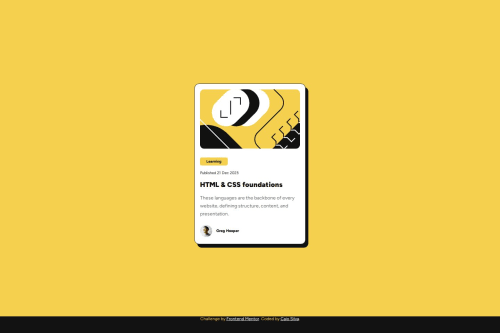Blog Preview Card Solution - HTML - CSS

Solution retrospective
-
Gostei de como ficou o
box-shadowdo card, estava em dúvida se utilizaria apenas essa propriedade ou se teria que unir com alguma outra para criar aquele efeito. No final percebi que era uma união entrebox-shadoweborder: 1px solid #000 -
Ainda estou entendendo o uso de variáveis no CSS, sei da importância pra manter a manutenção do código, mas imagino que para esse projeto em si não era tão adequado, por ter poucas linhas para alterar.
-
Utilizar o REM como unidade de medida foi um pouco complicado, não pelo calculo de conversão em si, mas saber onde utilizar. Teve um momento que me perguntei se era realmente uma boa ideia utiliza-lo no
widthde alguns elementos. -
No fim fui fazendo testes trocando o font-size do navegador, e percebi que todos os elementos mudavam de tamanho, oq me tranquilizou.
-
O que me preocupa um pouco é a organização do código, sinto que utilizei muitas classes e não sei se a maioria era realmente necessária. Também não sei se está semântico o suficiente, quase pensei em utilizar a tag
<figure>para a imagem do card, mas optei apenas pela<img>no final. -
Talvez eu esteja caçando erro, mas quando eu do um Zoom muito alto no site, o Footer acaba ficando "preso" no meio dele ao descer a pagina.
Please log in to post a comment
Log in with GitHubCommunity feedback
No feedback yet. Be the first to give feedback on Caio Lopes Silva's solution.
Join our Discord community
Join thousands of Frontend Mentor community members taking the challenges, sharing resources, helping each other, and chatting about all things front-end!
Join our Discord